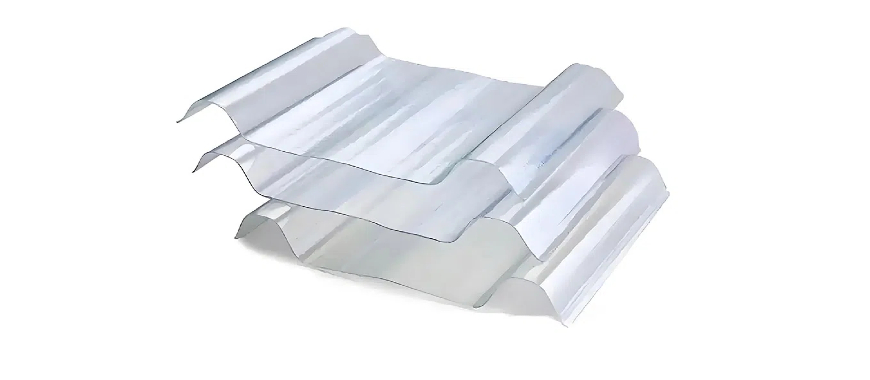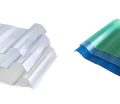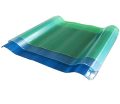
FRP transparent sheet is a versatile construction material offering strength, durability, and light-transmitting properties. Fiberglass Reinforced Plastic (FRP) combines fiberglass with a polymer matrix, creating a material suitable for demanding structural and aesthetic applications. Transparency plays a significant role in modern construction, enabling natural light to illuminate spaces while reducing energy costs. This characteristic makes FRP transparent sheet an ideal choice for areas requiring both strength and light diffusion. Common applications include greenhouses, skylights, and roofing systems where durability and functionality are essential. Additionally, its weather resistance and lightweight nature allow for easy installation in various settings. FRP transparent sheet has been increasingly utilized in industrial, residential, and agricultural projects due to its unique blend of properties and benefits.
Composition and Features of FRP Transparent Sheet
FRP transparent sheet combines innovative materials and unique features, making it a preferred choice for numerous construction applications. This material balances durability, transparency, and versatility, serving both structural and aesthetic purposes.
What is an FRP Transparent Sheet Made Of?
FRP transparent sheet is a composite material made by combining fiberglass with a polymer matrix, such as polyester or epoxy resin. This combination results in a lightweight yet strong material ideal for various construction needs.
- Fiberglass: Provides reinforcement, improving the material’s tensile strength and durability.
- Polymer Matrix: Acts as a binding agent, offering flexibility and resistance to environmental factors like moisture and chemicals.
The composition of FRP transparent sheet enables a unique balance of strength and transparency, making it suitable for demanding applications like skylights and roofing. This material is designed to handle harsh environments without compromising its structural integrity.
Key Features of FRP Transparent Sheet
FRP transparent sheet boasts several features that distinguish it from traditional materials. These features contribute to its growing popularity in construction and design projects.
- High Strength-to-Weight Ratio: FRP transparent sheet is both strong and lightweight, simplifying transportation and installation.
- UV Resistance: Provides protection against harmful ultraviolet rays, extending its lifespan in outdoor applications.
- Corrosion Resistance: Resists damage from chemicals, salt, and moisture, making it ideal for harsh industrial and coastal environments.
- Weather Resistance: Performs reliably in extreme temperatures, ensuring durability in varied climates.
- Lightweight: FRP transparent sheet is easy to cut, handle, and install, reducing labor costs and effort.
Benefits and Limitations
Benefits:
- Increases natural light penetration, reducing the need for artificial lighting.
- Enhances energy efficiency in spaces like greenhouses and industrial facilities.
- Offers long-lasting performance with minimal maintenance.
Limitations:
- May be more expensive initially than some traditional materials.
- Transparency might reduce privacy in certain applications without additional treatments.
Examples of Usage
- Greenhouses: FRP transparent sheet ensures optimal light diffusion for plant growth.
- Industrial Skylights: Enhances workplace visibility while maintaining structural strength.
- Outdoor Canopies: Protects from weather while allowing natural light to pass through.
Research highlights its effective use in energy-efficient building designs, showing measurable reductions in energy consumption when incorporated into roofing and façade systems.
FRP Glass Board Sheets: Custom Sizes and Colors
Benefits of Using FRP Transparent Sheet
FRP transparent sheet offers numerous advantages that make it a preferred material in modern construction. Its durability, light-transmitting properties, and ease of use contribute to its popularity in both industrial and residential settings.
Durability and Strength
FRP transparent sheet is renowned for its exceptional durability and impressive strength-to-weight ratio. These properties make it suitable for demanding environments where traditional materials might fail.
- Resistance to Corrosion:
FRP transparent sheet resists damage caused by chemicals, salt, and moisture, making it perfect for coastal and industrial areas. - Withstands Harsh Conditions:
The material performs reliably in extreme temperatures, heavy rainfall, and exposure to UV rays. - Applications:
- Used in factories to withstand chemical exposure and heavy machinery vibrations.
- Ideal for warehouses where strength and durability are critical.
- Case Example:
Research shows that FRP transparent sheet maintains structural integrity longer than traditional materials in high-humidity environments.
The combination of strength and lightweight composition ensures longevity without compromising safety.
Transparency and Light Transmission
The semi-transparent or translucent nature of FRP transparent sheet allows optimal light diffusion, reducing the need for artificial lighting. This feature not only saves energy but also improves the overall aesthetics of a space.
- Light Diffusion:
Semi-transparent FRP sheets distribute light evenly, preventing harsh glare. - Energy Efficiency:
Buildings using FRP transparent sheet experience reduced energy costs by maximizing natural light. - Applications:
- Greenhouses: Allows light to penetrate for plant growth without overheating the interior.
- Skylights: Provides natural lighting in residential and commercial spaces, enhancing comfort and visibility.
- Outdoor Canopies: Offers shaded yet bright spaces for recreational or commercial purposes.
- Case Study:
A greenhouse equipped with FRP transparent sheet demonstrated increased crop yield due to optimal light transmission and regulated temperatures.
The ability to combine aesthetics with functionality makes FRP transparent sheet ideal for various projects.
Easy Installation and Maintenance
FRP transparent sheet is lightweight, making it easier to handle and install compared to many traditional materials. Its minimal maintenance requirements further enhance its cost-effectiveness.
- Ease of Installation:
- Lightweight nature reduces transportation costs and effort.
- Can be easily cut, molded, or drilled to fit specific requirements.
- Quick installation processes save labor time and expenses.
- Low Maintenance Needs:
- Requires simple cleaning to maintain transparency and performance.
- Resistant to common forms of damage like rust or cracking, ensuring long-term reliability.
- Applications:
- Roofing systems where quick setup is essential.
- Temporary structures needing easy disassembly and reuse.
- Advantages Over Alternatives:
Unlike glass, FRP transparent sheet is less prone to shattering, reducing replacement costs. - Example of Use:
Industrial facilities have successfully replaced traditional roofing materials with FRP transparent sheet, cutting down installation time by 30%.
Additional Benefits
- Environmental Impact:
FRP transparent sheet supports sustainable construction by reducing energy consumption through enhanced natural lighting. - Versatility in Design:
Its flexibility allows for custom shapes and sizes, meeting unique architectural needs.
Limitations
While the benefits are significant, it’s important to note:
- Initial costs may be higher compared to alternatives like polycarbonate sheets.
- Full transparency may not match the needs of projects requiring completely clear materials.
The durability, light transmission, and ease of use of FRP transparent sheet make it a superior choice for many applications. Its ability to withstand harsh environments, enhance natural lighting, and simplify installation ensures long-lasting performance and cost savings. From greenhouses to skylights, FRP transparent sheet offers unmatched versatility for modern construction needs.
Comparing FRP Transparent Sheet to Other Materials
FRP transparent sheet stands out in various ways when compared to alternative materials, including polycarbonate sheets. This section provides an in-depth comparison to help identify the best material for specific applications.
FRP Transparent Sheet vs Polycarbonate Sheets
FRP transparent sheet and polycarbonate sheets have unique characteristics that suit different needs. The table below highlights the key differences:
| Feature | FRP Transparent Sheet | Polycarbonate Sheets |
|---|---|---|
| Transparency and Light Transmission | Semi-transparent, provides diffused light for even illumination. | Highly transparent, offers clear or tinted options for direct light. |
| Strength | High strength-to-weight ratio, suitable for heavy-duty applications. | Strong but slightly less durable under extreme conditions. |
| Impact Resistance | Resists mechanical stress and wear in harsh environments. | Superior impact resistance, especially in high-traffic areas. |
| Weather Resistance | Excellent resistance to UV, corrosion, and temperature extremes. | UV-stabilized but may yellow over time with prolonged exposure. |
| Applications | Greenhouses, industrial roofing, and outdoor canopies. | Skylights, windows, and decorative panels. |
| Flexibility | Moldable into complex shapes for custom designs. | Easily bent or thermoformed for curved or unique surfaces. |
| Maintenance | Requires minimal maintenance, retains performance over time. | Requires periodic cleaning to maintain optical clarity. |
| Cost | Higher initial cost due to durability and strength. | Typically more affordable upfront for standard uses. |
Detailed Analysis
- Transparency and Light Transmission:
- FRP Transparent Sheet: Provides diffused light, ideal for greenhouses where plants benefit from even light distribution.
- Polycarbonate Sheets: Allows direct light, making them better for spaces requiring clear visibility, like skylights.
- Strength and Impact Resistance:
- FRP Transparent Sheet: Withstands high loads and chemical exposure, perfect for industrial settings.
- Polycarbonate Sheets: Absorbs heavy impacts, making it ideal for areas prone to accidents or debris.
- Applications:
- FRP Transparent Sheet: Best suited for agricultural and industrial projects due to its durability and light diffusion.
- Polycarbonate Sheets: Common in residential or decorative uses where transparency is key.
Choosing between FRP transparent sheet and polycarbonate sheets depends on the specific requirements of the project. FRP transparent sheet excels in durability and weather resistance, making it ideal for demanding environments. Polycarbonate sheets, on the other hand, offer higher transparency and flexibility for decorative or light-weight applications. Understanding these distinctions ensures the right material is selected for maximum efficiency and performance.
Applications of GRP Laminate Sheet in Construction
Applications of FRP Transparent Sheet
FRP transparent sheet is a versatile material with diverse applications across residential, industrial, and agricultural projects. Its unique properties make it suitable for multiple uses, balancing functionality and aesthetics.
Roofing and Skylights for Residential and Industrial Buildings
FRP transparent sheet is widely used in roofing systems due to its light-transmitting and durable properties.
- Residential Roofing:
- Provides natural lighting, reducing energy consumption.
- Ideal for patio or balcony covers, enhancing outdoor aesthetics.
- Industrial Skylights:
- Offers even light distribution across large spaces, improving workplace visibility.
- Resistant to chemicals and corrosion, suitable for factories or warehouses.
- Example:
Studies have shown that industrial facilities with FRP transparent sheet skylights experience reduced electricity costs and improved worker productivity.
Greenhouses and Agricultural Covers
FRP transparent sheet is a preferred choice for agricultural applications due to its optimal light diffusion and weather resistance.
- Greenhouses:
- Supports plant growth by providing balanced light and reducing temperature fluctuations.
- UV-resistant, ensuring long-term durability without degrading.
- Agricultural Covers:
- Protects crops from rain, hail, and extreme sunlight.
- Lightweight, enabling easy installation and adjustment.
- Case Study:
A greenhouse using FRP transparent sheet reported a 20% increase in crop yield compared to traditional materials, thanks to its superior light transmission.
Outdoor Canopies, Pergolas, and Translucent Partitions
FRP transparent sheet enhances outdoor spaces while offering functionality and protection.
- Canopies and Pergolas:
- Provides shade while allowing natural light to filter through.
- Withstands heavy rains and wind, making it ideal for parks or gardens.
- Translucent Partitions:
- Used in public spaces to create bright, open environments.
- Provides privacy while maintaining a light and airy feel.
- Example of Use:
Recreational areas with FRP transparent sheet canopies have become popular for their modern aesthetics and user-friendly design.
FRP Transparent Plain Sheet
FRP transparent plain sheet offers unique benefits for projects requiring flat, smooth surfaces. Its properties differ from corrugated options, making it suitable for specific applications.
Overview of FRP Transparent Plain Sheet
FRP transparent plain sheet is a flat, lightweight material designed for both decorative and functional purposes.
- Provides a sleek, smooth appearance for architectural designs.
- Delivers the same strength and weather resistance as corrugated sheets.
- Easy to cut, shape, and install for customized applications.
Unique Characteristics of Plain Sheets Compared to Corrugated Options
FRP transparent plain sheet differs from corrugated sheets in several key aspects:
- Surface Design:
- Plain sheets offer a uniform surface, ideal for decorative projects.
- Corrugated sheets provide structural rigidity, better suited for heavy loads.
- Flexibility:
- Plain sheets can be used in flat roofing or walls requiring seamless finishes.
- Corrugated sheets are preferred for curved or reinforced structures.
Applications of FRP Transparent Plain Sheet
FRP transparent plain sheet is ideal for applications demanding a flat, polished surface with light transmission.
- Decorative Panels:
- Used in architectural facades and interior design for a modern aesthetic.
- Enhances natural light without compromising privacy.
- Flat Roofing:
- Suitable for carports or small residential projects requiring a minimalist look.
- Provides excellent protection from weather while maintaining a sleek appearance.
- Example of Use:
Modern office spaces use FRP transparent plain sheet for partition walls, blending natural lighting with contemporary design.
FRP transparent sheet, including plain sheet variants, is highly versatile and adaptable. Whether for agricultural, industrial, or decorative purposes, it offers unmatched durability, transparency, and ease of use.
Key Benefits of FRP Electrical Insulation Sheet for Safety
Factors to Consider When Choosing FRP Transparent Sheet
At GangLong Fiberglass, we pride ourselves on offering high-quality solutions tailored to diverse project needs. When selecting an FRP transparent sheet, it’s essential to assess several factors to ensure optimal performance and longevity. Below, we highlight critical considerations to guide your choice.
Transparency Levels: Fully Transparent and Semi-Transparent
The level of transparency in an FRP transparent sheet can significantly impact its functionality and aesthetic appeal.
- Fully Transparent Sheets:
- Allow maximum light transmission, ideal for projects requiring clear visibility.
- Commonly used in greenhouses, skylights, and areas where direct natural light is a priority.
- Provide a modern, sleek appearance for architectural designs.
- Semi-Transparent Sheets:
- Diffuse light evenly, reducing glare and creating softer illumination.
- Suitable for industrial roofing, partitions, and outdoor canopies where a balance of privacy and light is required.
- Enhance energy efficiency by minimizing heat transfer in sunny conditions.
Our team at GangLong Fiberglass recommends fully transparent sheets for projects emphasizing visibility and semi-transparent sheets for diffused lighting requirements.
Thickness and Dimensions Based on Project Requirements
The thickness and size of an FRP transparent sheet are crucial for ensuring structural integrity and proper application.
- Thickness Options:
- Thicker sheets offer enhanced strength and durability, suitable for high-load areas like industrial roofs or heavy-duty canopies.
- Thinner sheets are lightweight and easier to install, making them ideal for residential or decorative uses.
- Dimensions:
- Customizable lengths and widths accommodate unique project specifications.
- Larger sheets reduce seams, providing a cleaner finish and improved water resistance.
At GangLong Fiberglass, we assist in selecting the right thickness and dimensions to match specific project needs, ensuring functionality and aesthetic appeal.
Compatibility with Environmental Conditions
Environmental factors such as UV exposure and temperature variations influence the longevity and performance of an FRP transparent sheet.
- UV Exposure:
- UV-resistant coatings protect against degradation and discoloration.
- Essential for outdoor applications like roofing and greenhouses where prolonged sunlight exposure occurs.
- Temperature Variations:
- FRP transparent sheets maintain stability in extreme temperatures, making them ideal for regions with fluctuating weather.
- Resistance to thermal expansion prevents warping, ensuring long-term structural integrity.
- Environmental Adaptability:
- Designed to withstand corrosion in coastal or industrial areas.
- Resilient against wind and hail, providing reliable performance in harsh climates.
At GangLong Fiberglass, we offer expert guidance to ensure the FRP transparent sheet you choose is perfectly suited to your environment.
By considering transparency levels, thickness, dimensions, and environmental compatibility, we at GangLong Fiberglass help you achieve the best results for your projects. Whether you require fully transparent sheets for maximum visibility or semi-transparent options for diffused light, our products are tailored to meet your specific needs.
FAQs about FRP Transparent Sheet
FRP (Fiberglass Reinforced Plastic) is a composite material made of fiberglass and a polymer matrix, while polycarbonate is a thermoplastic polymer. FRP sheets are semi-transparent or translucent, offering light diffusion, while polycarbonate sheets are highly transparent, allowing direct light transmission. FRP is stronger and more durable in extreme environments, resisting corrosion, UV rays, and harsh weather. Polycarbonate excels in impact resistance and flexibility, making it ideal for applications requiring curved or molded designs. Choosing between the two depends on project requirements, such as strength, transparency, or environmental conditions.
FRP sheets are used in construction for their durability, light transmission, and weather resistance. They are commonly applied in skylights, roofing, greenhouses, and industrial buildings. These sheets offer an excellent balance of strength and lightweight properties, making them easy to install and maintain. Their resistance to UV rays, chemicals, and corrosion ensures long-lasting performance. FRP sheets are also versatile, suitable for decorative panels, translucent partitions, and outdoor canopies where natural lighting is essential.
FRP sheets are available in various thicknesses to suit different applications, typically ranging from 0.5 mm to 5 mm. Thicker sheets provide greater strength and durability, ideal for heavy-duty uses like industrial roofing or high-load structures. Thinner sheets are lightweight and easy to handle, making them perfect for residential projects or decorative applications. The required thickness depends on factors such as load-bearing needs, environmental exposure, and project dimensions. Consulting with suppliers helps determine the ideal thickness for specific purposes.
FRP in roofing refers to the use of fiberglass reinforced plastic sheets for roofing systems. These sheets provide excellent durability, light diffusion, and weather resistance, making them suitable for residential, industrial, and agricultural roofs. FRP roofing sheets are lightweight, reducing structural load and simplifying installation. They resist UV rays, moisture, and corrosion, ensuring long-term performance. FRP is also versatile, allowing customization for various roofing designs, including flat, curved, or translucent structures. Their ability to transmit natural light makes them a cost-effective choice for energy-efficient roofing solutions.

As the editor of GangLong Fiberglass, I have years of experience and in-depth research, focusing on cable tray products, fiberglass solutions, and grille systems. I incorporate years of industry insights and practical experience into every content, committed to promoting the progress of the industry. At GangLong Fiberglass, my commitment is reflected in every product, from innovative cable trays to durable fiberglass solutions and sturdy grille systems. As an authoritative voice in the industry, my goal is to provide valuable information to professionals and businesses and promote forward-looking solutions.


